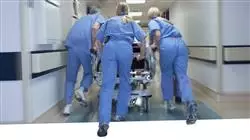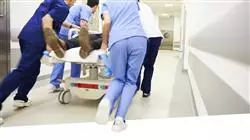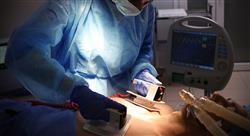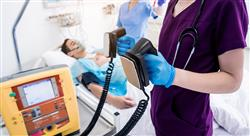University certificate
The world's largest faculty of medicine”
Why study at TECH?
Throughout these months you will learn to apply the clinical and non-clinical competencies of emergency and disaster medicine"

Health professionals play a key role in caring for a patient with an emergency medical condition or in an emergency situation, in order to maintain the required level of quality and safety. Adequate updating of specialists in these areas is essential to ensure better early diagnosis and the operability of hospital and out-of-hospital services. On the other hand, in disaster situations, the preparation of material and human resources remains inadequate. Because of this, many health facilities emphasize the need for experts with an emphatic preparation for this kind of care response.
It is from this context that this TECH academic program arises. It integrates the latest advances in the diagnosis and treatment of patients injured during serious accidents or natural phenomena. In addition, you will learn more about the importance of equipping the means of transport in an optimal way and the knowledge that a professional in this sanitary branch must have to prepare these transports. It will also discuss the most current trends that differentiate the care of adult patients from those of pediatric age during medical care following an emergency or disaster.
This program combines very complete theoretical contents with a face-to-face and exhaustive stay in a first class medical facility. This practice will be extended from Monday to Friday, in 8-hour shifts, for 3 weeks. They will be supervised by a designated tutor, who will be in charge of facilitating the students' insertion into the most demanding and rigorous work dynamics. In this way, the student will develop new knowledge from the subjects taught on TECH 100% online platform, and then achieve the skills most demanded by the sector with the help of the most competent specialists. This innovative learning modality will favor the immediate insertion of graduates in first level jobs in the healthcare field.
Add to your online study the realization of clinical practices with the highest standards of quality and technological level in an elite hospital center"
This ##ESTUDIO## in Emergency and Catastrophic Medicine the most complete and up-to-date scientific program on the market. The most important features include:
- Development of more than 100 clinical cases, presented by experts in the care of patients in emergencies, emergencies and catastrophes and university professors with extensive experience in this field
- The graphic, schematic, and practical contents with which they are created, provide scientific and practical information on the disciplines that are essential for professional practice
- News on patient care in emergencies, emergencies and catastrophes
- Practical exercises where the self-assessment process can be carried out to improve learning
- Its emphasis on innovative methodologies in emergency, urgent and catastrophic patient care
- All this will be complemented with theoretical lessons, questions to the expert, discussion forums on controversial issues and individual reflection work
- Availability of content from any fixed or portable device with an Internet connection
- In addition, you will be able to carry out a clinical internship in one of the best hospitals in the world
Take an intensive 3-week program at a prestigious medical institution and acquire all the knowledge you need to grow personally and professionally"
In this Professional Master's Degree proposal, of a professionalizing nature and blended learning modality, the program is intended to update nursing professionals who develop their functions in high performance centers, clinical or hospital centers, and who require a high level of qualification. The content is based on the latest scientific evidence and is organized in a didactic way to integrate theoretical knowledge into nursing practice. The theoretical-practical elements allow professionals to update their knowledge and help them to make the right decisions in patient care.
The multimedia content developed with the latest educational technology will provide the professional with situated and contextual learning, i.e., a simulated environment that will provide an immersive education program to learn in real situations.
This program's design is based on Problem Based Learning, by means of which the student must try to solve different professional practice situations that will be presented throughout the program. For this purpose, the student will be assisted by an innovative interactive video system created by renowned experts.
Enroll now in this unique Hybrid professional master’s degree, which stands out for the quality of its contents and its excellent teaching staff, composed of elite professionals"

This program gives you the opportunity to update your knowledge in a real scenario, with the maximum scientific rigor of an institution at the forefront of technology"
Temario
La estructura del plan de estudios ha sido diseñada por un equipo de profesionales conocedor de las implicaciones de la formación médica para el abordaje del paciente crítico, en el ámbito de urgencias y catástrofes, conscientes de la relevancia de la actualidad de la formación, y comprometidos con la enseñanza de calidad mediante las nuevas tecnologías educativas.

Este Hybrid professional master’s degree en Emergency and Catastrophic Medicine contiene el programa científico más completo y actualizado del mercado”
Módulo 1. Generalidades
1.1. Definiciones y conceptos
1.2. Atención integral
1.3. Bioética y Legislación en Urgencias y Emergencias
1.4. Bioética
1.5. Legislación
Módulo 2. Servicios de emergencias y transporte sanitario
2.1. Organización de los Sistemas de Emergencias médicas
2.2. Coordinación y regulación sanitaria
2.3. Sistemas de información y registros
2.4. Tipos de transporte sanitario
2.4.1. Transporte intrahospitalario
2.4.2. Transporte interhospitalario
2.4.3. Transporte Sanitario Terrestre
2.4.4. Transporte Sanitario Aéreo
2.5. Tipos de recursos sanitarios extrahospitalarios
2.6. Fisiopatología del Transporte Sanitario y posiciones del traslado
2.7. Transferencia del paciente. Modelos
Módulo 3. Soporte cardiovascular avanzado
3.1. Soporte vital básico en el adulto
3.1.1. Generalidades
3.2. Soporte vital avanzado en el adulto
3.2.1. Actuación ante bradiarritmia
3.2.2. Actuación ante taquiarritmias
3.3. Soporte vital básico pediátrico
3.4. Soporte vital avanzado pediátrico y neonatal
3.4.1. Reconocimiento y manejo del niño gravemente enfermo
3.4.2. Manejo avanzado de la Vía Aérea
3.4.3. Conceptos básicos de la ventilación mecánica en pediatría
3.4.4. Vías de infusión y fármacos en RCP pediátrica
3.4.5. Algoritmos de SVA pediátrico y tratamiento de las arritmias
3.5. Reanimación neonatal
3.5.1. Estabilización y transporte neonatal
3.6. Soporte vital avanzado en el paciente con trauma grave
3.7. Soporte vital avanzado en casos especiales
Módulo 4. Emergencias cardiovasculares
4.1. Arritmias
4.2. Síncope
4.3. Dolor torácico agudo
4.4. Insuficiencia cardiaca aguda
4.5. Pericarditis, taponamiento cardiaco
4.6. Insuficiencia cardiaca
4.7. Edema agudo de pulmón
4.8. Trombosis venosa profunda (TVP)
4.9. Tromboembolismo pulmonar (TEP)
4.10. Disección aórtica
4.11. Emergencias hipertensivas
4.12. Shock
Módulo 5. Emergencias Respiratorias
5.1. Emergencias respiratorias
5.2. Neumonía
5.3. Exacerbación de la EPOC
5.4. Pleuritis y derrame pleural
5.5. Neumotórax
5.6. Hemoptisis
Módulo 6. Emergencias neurológicas
6.1. Valoración neurológica del paciente crítico
6.2. Trastornos vasculares, código ictus
6.3. Alteraciones del nivel de consciencia
6.4. Hipertensión intracraneal
6.5. Infecciones del sistema nervioso central
6.6. Crisis comiciales y estatus epiléptico
6.7. Cefaleas
6.8. Síndrome vertiginoso (Vértigo)
Módulo 7. Emergencias digestivas
7.1. Dolor abdominal agudo
7.2. Hemorragia digestiva aguda y trastornos vasculares
7.3. Obstrucción intestinal
7.4. Gastroenteritis aguda
7.5. Pancreatitis aguda
7.6. Patología biliar aguda
7.7. Patología anal aguda
Módulo 8. Emergencias Endocrinometabólicas
8.1. Trastornos del metabolismo de la glucosa
8.2. Urgencias tiroideas
8.3. Transtornos del equilibrio ácido-base
8.4. Trastornos del equilibrio hídrico
8.5. Trastornos del equilibrio electrolítico
Módulo 9. Emergencias Nefrourológicas
9.1. Emergencias nefrourológicas
9.2. Litiasis renal y del sistema excretor
9.3. Retención urinaria
9.4. Infecciones del tracto urinario
9.5. Fracaso renal agudo
9.6. Hematuria
9.7. Síndrome escrotal agudo
9.8. Patología uretral
Módulo 10. Emergencias Hematológicas, inmunológicas e infecciosas
10.1. Hemoterapia
10.2. Trombopenia
10.3. Anticoagulación y tromboprofilaxis
10.4. Alergias y reacciones anafilácticas
10.5. Exposición de riesgo y exposición a material potencialmente contaminante
10.6. Fiebre de origen desconocido
10.7. Sepsis y shock séptico
Módulo 11. Emergencias psiquiátricas
11.1. Psicopatologías
11.2. Agitación psicomotriz
11.3. Patología aguda alcohólica
11.4. Intento autolítico
11.5. Crisis de ansiedad
11.6. Síndrome neuroléptico maligno
Módulo 12. Emergencias oftalmológicas
12.1. Enfermedades de los párpados y sistema lagrimal
12.2. Ojo rojo
12.3. Pérdida brusca de visión
12.4. Agresiones oculares
Módulo 13. Emergencias otorrinolaringológicas
13.1. Procesos infecciosos en ORL
13.2. Cuerpos extraños en ORL
13.3. Epistaxis
13.4. Sordera súbita
Módulo 14. Emergencias toxicológicas
14.1. Aspectos generales del paciente intoxicado
14.2. Intoxicaciones más frecuentes
Módulo 15. Paciente terminal en urgencias
15.1. Complicaciones urgentes del paciente terminal
15.2. Atención a la situación de últimos días
15.3. Dermatología en urgencias
15.4. Donación de órganos y tejidos
Módulo 16. Emergencias obstétricas
16.1. Trastornos inflamatorios, infecciosos y otras urgencias
16.2. Hemorragias ginecológicas
16.3. Urgencias durante el embarazo y puerperio
16.4. Asistencia al parto en emergencias
16.5. Abuso sexual ( doc no envío retro )
Módulo 17. Urgencias y emergencias pediátricas
17.1. Cólico del lactante
17.2. Síndrome febril
17.3. Convulsiones
17.4. Patología de las vías respiratorias
17.5. Enfermedades exantemáticas
17.6. Patología digestiva
17.7. Maltrato infantil
17.8. Transporte del paciente crítico pediátrico
Módulo 18. Atención al trauma grave (Catástrofes o EEH)
18.1. Generalidades
18.2. Biomecánica de los accidentes
18.3. Valoración primaria y secundaria
18.4. TCE
18.5. Traumatismo torácico
18.6. Traumatismo abdominal
18.7. Traumatismo vertebral y lesión medular
18.8. Traumatismo del aparato locomotor
18.9. Heridas
18.10. Shock hipovolémico
18.11. Trauma pediátrico
18.12. Trauma en la embarazada
18.13. Traumatismos especiales
18.14. Traumatismos por agentes físicos y ambientales
18.15. Mordeduras y picaduras
18.16. Analgesia y sedación
18.17. Movilización e inmovilización. Materiales y técnicas
18.18. Rescate y asistencia sanitaria en lugares confinados y remotos
Módulo 19. Incidentes de múltiples víctimas (IMV) y catástrofes
19.1. Generalidades
19.2. Gestión de IMV y Catástrofes
19.3. Sectorización
19.4. Despliegue y Logística
19.5. Triaje
19.6. Atención a múltiples víctimas
19.7. Evacuación
19.8. La gestión de un IMV en un hospital
19.9. Incidentes NBQR
19.10. Planes de Emergencia
Módulo 20. Técnicas diagnósticas y terapéuticas (EHH y catástrofes)
20.1. Sondajes
20.2. Canalización venosa periférica y central
20.3. Vía intraósea
20.4. IOT
20.5. Vía aérea difícil
20.6. Ventilación Mecánica Invasiva
20.7. Manejo de la Ventilación Mecánica No Invasiva
20.8. Pericardiocentesis
20.9. Toracocentesis y drenaje pleural
20.10. Ecografía de urgencias
20.11. Terapia eléctrica (MP, CV, DF)
20.12. Monitorización del estado hemodinámico y electrocardiografía
20.13. Capnografía y pulsioximetría
20.14. Oxigenoterapia
20.15. Monitorización del estado neurológico
20.16. Monitorización de la sedoanalgesia
20.17. Recogida de muestras analíticas
20.18. Escalas de uso frecuente en urgencias y emergencias
20.19. Parámetros fisiológicos en adultos y niños
Módulo 21. Farmacología en la emergencia
21.1. Conceptos básicos
21.2. Vías de administración de fármacos en urgencias y emergencias
21.3. Seguridad en la administración de fármacos
21.4. Fluidoterapia
21.5. Fármacos más frecuentes en urgencias y emergencias
21.6. Fórmulas y cálculo de dosis
Módulo 22. Otros aspectos importantes en urgencias y emergencias
22.1. Habilidades de comunicación en urgencias
22.2. Seguridad del paciente
22.3. Nuevas competencias del profesional en urgencias y emergencias
22.4. Nuevas tecnologías en urgencias y emergencias
Módulo 23. Actualidad en las infecciones por coronavirus
23.1. Descubrimiento y evolución de los coronavirus
23.2. Principales características microbiológicas y miembros de la familia de coronavirus
23.3. Cambios epidemiológicos en las infecciones por coronavirus desde su descubrimiento a la actualidad
23.4. El sistema inmune y las infecciones por coronavirus
23.5. Patogenia y fisiopatología de las infecciones por coronavirus
23.6. Grupos de riesgos y mecanismos de transmisión de los coronavirus
23.7. Historia natural de las infecciones por coronavirus
23.8. Diagnóstico microbiológico actualizado de las infecciones por coronavirus
23.9. Bioseguridad actual en los laboratorios de microbiología para el manejo de muestras de coronavirus
23.10. Manejo actualizado de las infecciones por coronavirus
23.11. Desafíos futuros en la prevención, diagnóstico y terapéutica de las infecciones por coronavirus

Una experiencia de actualización única, clave y decisiva para impulsar tu desarrollo profesional”
Hybrid Professional Master's Degree in Emergency and Catastrophic Medicine
Emergency, emergency and catastrophe medicine is a fundamental specialty in the field of health, which requires highly trained professionals to provide adequate care in critical situations. At TECH Global University, we understand the importance of having experts in this field, and that is why we have designed ourHybrid Professional Master's Degree in Emergency and Catastrophic Medicine to train the professionals of the future. This postgraduate program offers a unique combination of theoretical and practical lessons, with blended learning classes that will allow you to acquire the knowledge and skills necessary to face any emergency situation with confidence and efficiency. In our Hybrid Professional Master's Degree, you will have a state-of-the-art, updated and high quality study. Our team of professors is composed of experts in the field of emergency medicine and catastrophes, who will guide you in your learning process and will provide you with the necessary tools to face the challenges that may arise in critical situations. In addition, our blended learning methodology will allow you to access the contents of the program online, adapting to your pace and schedule, while face-to-face classes will give you the opportunity to practice and apply what you have learned in a realistic and safe environment.
Specialize in the Largest Medical School
By taking our Hybrid Professional Master's Degree, you'll benefit from comprehensive training that includes up-to-date knowledge, practical skills and clinical experience. You will learn to make quick and accurate decisions in emergency situations, effectively manage available resources, coordinate multidisciplinary teams and lead in crisis situations. In addition, you will have the opportunity to establish professional networks with other students and experts in the field, which will allow you to broaden your horizons and enrich your learning. This Hybrid Professional Master's Degree in Emergency and Catastrophic Medicine is a unique opportunity to become a highly skilled professional in this crucial field of medicine. Don't wait any longer to improve your skills and advance your career - enroll in our program and become an expert in emergency medicine!







